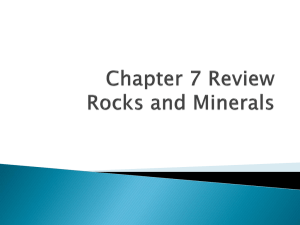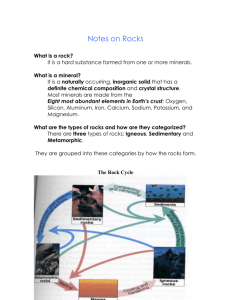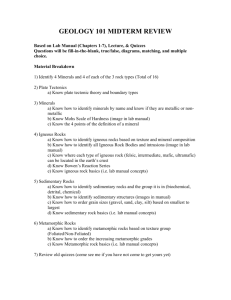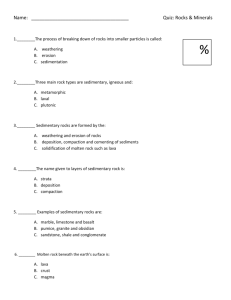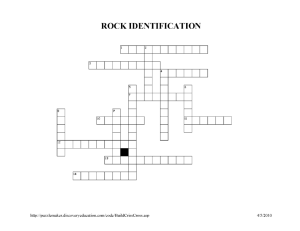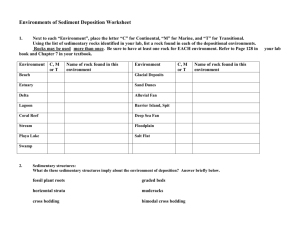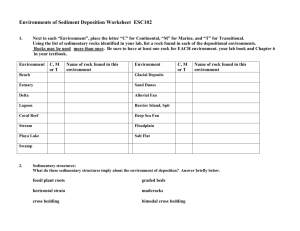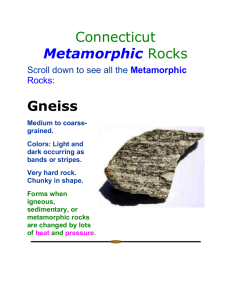The rock cycle
advertisement
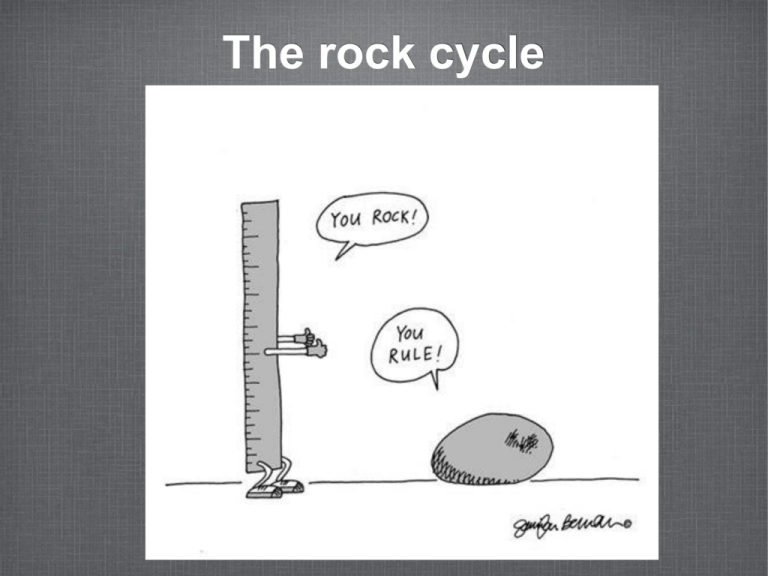
The rock cycle Before we look at the Rock Cycle in more detail, let’s review some basic information … Atoms combine to make compounds that combine to make minerals. Minerals are Solid, Naturally occurring, Inorganic a Fixed chemical composition, And has Crystal form SNIFC alunite, amethyst, amphibole, analcite, anatase, andalusite, andesine, andradite, anglesite, anhydrite, ankerite, annabergite, anorthite, anthonyite, anthophyllite, anthraconite, anthraxolite, antigorite, apatite, aphrosiderite, apophyllite, aragonite, ardennite, argentoalgodonite, arsenopyrite, asbestos, atacamite, attapulgite, augite,awarurite, axinite, azurite, babingtonite, baddeleyite, barite, bassetite, bastnaesite, beaconite, beryl, biotite, bismuthinite, blomstrandine, bornite, bowlingite, brannerite, braunite, brochantite, bronzite, brookite, brucite, brunsvigite, buttgenbachite, byssolite, bytownite, calciovolborthite, calcite, calderite, calumetite, carnallite, carnelian, celadonite, celestite, cerargyrite, chabazite, chalcedony, chalcocite, chalconatronite, chalcopyrite, chalcotrichite, chamosite, chert, chloanthite, chlorargyrite, chlorastrolite, chlorite, clinochlore, clino-chrysotile, clinozoisite, collophane, columbite, copiapite, copper, coquimbite, cordierite, corrensite, corundum, covellite, crocidolite, cubanite, cummingtonite, cuprite, dahllite, datolite, daubreelite, delessite, diabantite, diallage, diamond, dickite, digenite, dihydrite, diopside, dioptase, djurleite, dolomite, domeykite, forsterite, francolite, freirinite, fuchsite, fulgurite, galena, garnet, garnierite, gersdorffite, gibbsite, glauconite, goethite, gold, halite, halloysite, halotrichite, harmotome, heterosite, heulandite, hisingerite, hollandite, hornblende, hyacinth, hydrocarbon, hydrohausmannite, hydromica, hydromuscovite, hydrotroilite, hypersthene, iddingsite, illite, ilmenite, isle royale greenstone, jacksonite, jacobsite, jasper, jaspilite, julgoldite, kamacite, kamiokite, kaolinite, kearsargeite, keweenawite, kinoite, koutekite, kupfferite, kutnahorite, kyanite, labradorite, langite, laumontite, lavendulan, lead, lechetelierite, ledouxite, leonhardite, lepidocrocite, lepidolite, manganoan siderite, manganocalcite, marcasite, margarite, marmolite, martite, masonite, maucherite, melaconite, melanochalcite, melanterite, melilite, mercury, mesolite, meta-autunite, metatorbernite, metatyuyamunite, microcline, millerite, minnesotaite, mirabilite, mohawk-algodonite, mohawkite, molybdenite, monazite, montmorillonite, muscovite, nacrite, nantokite, natrojarosite, natrolite, neltnerite, neotocite, niccolite, nontronite, oligoclase, oligonite, olivenite, olivine, orientite, orthoclase, ottrelite, palygorskite, paragonite, paramelaconite, pararammelsbergite, paratacamite, pargasite, patricianite, paxite, pectolite, pennine, pentlandite, peristerite, perthite, pharmacolite, phengite, phillipsite, phlogopite, phosphides, phosphorite, picrolite, picropharmacolite, pigeonite, pistacite, pitchblende, plagioclase, plancheite, plessite, polyhalite, posnjakite, powellite, prehnite, priorite, prochlorite, protolithionite, pyrolusite, pyrope, pyrophyllite, pyrostilpnite, pyroxene, pyrrhotite, quartz, rammelsbergite, rauenthalite, rhodochrosite, rhodonite, riebeckite, ripidolite, roscoelite, rubellan, rutherfordine, rutile, salite, salt, sanidine, saponite, saussurite, scapolite, scheelite, schefferite, schorl, schreibersite, scolectite, seamanite, semi-whitneyite, sericite, serpentine, siderite, silicon, sillimanite, silver, smaltite, smectite, soapstone, specularite, spessartite, sphalerite, sphene, spinel, spodumene, staurolite, steatite, stellerite, stibiodomeykite, stilbite, stilpnomelane, stinkstone, strontianite, sulfur, sussexite, sylvanite, sylvite, synchisite, szaibelyite, taenite, talc, tantalite, tellurium, tenorite, tetrahedrite, thomsonite, thuringite, tirodite, titanite, titanomagnetite, topaz, tourmaline, tremolite, trichalcite, tridymite, troilite, tyrolite, uralite, uraninite, uranothorite, uvarovite, vaterite,, vesuvianite, violarite, viridite, vivianite, vladimirite, wairakite, whitneyite, williamsite, wollastonite, wurtzite, xanthosiderite, xonotlite, zeolite, zircon, zoisite, zonochlorite There are over 2,000 minerals Minerals combine to form Rocks Rocks are made up of just one mineral - like rock salt (made up of Some the mineral halite) that is mined near Detroit. Others Rocks are made up of minerals - like the many granites and gneisses (made up of feldspars, quartz, and other minerals) found near Marquette. What is the Rock Cycle ? The rock cycle is a sequence of events involving formation, alteration, destruction, and reformation of rocks as a result of natural processes such as magmatism (melting of rock into magma), erosion, transportation, deposition, lithification, and metamorphism. the Glossary of Geology, Bates & Jackson, AGI The mantle, crust and surface of the earth can be thought of as a giant recycling machine; rocks are neither created nor destroyed, but redistributed and transformed from one rock type to another. http://www.science.ubc.ca/~geol202/rock_cycle/rockcycle.html March 2000 The Rock Cycle involves the recognition of three main classes of rocks all of which are found in Utah. The three rock types are … Sedimentary CEMETERY Rocks Metamorphic METABOLIC Rocks Igneous INGENIOUS Rocks Right? Igneous Igneous means “born of fire” Igneous Rock... is formed when sediments are melted and cooled Igneous ... Cools Very Fast - glassy with holes Cools Fast - glassy Cools Slow- small crystals Cools Very Slow- large crystals. As Cooling Time increases, Crystal Size increases. Bedrock Mag-ma! Into the Bedrock intrusive (crystals) On top (Exit) extrusive (no crystals) Sedimentary rock... is formed when sediment that has been broken down in some way is pressed and cemented together. Sedimentary rocks are usually formed in a watery environment. Often layered Are the only rocks that contain fossils Sedimentary Rock... Can have thick or thin layers Loosely Compacted Have distinct particles (Usually) dull luster Metamorphic rock... is formed when rocks are changed by heat and pressure. metamorphic... Metamorphic rocks will often have foliation or a distorted structure. Bands (can) form Metamorphic means “changed” Metamorphic! Metamorphic... Usually have Thin layers Are Tightly Compacted Have Blurred or stretched particles & are Usually shiny Draw three ovals on your paper. What should go in the blue oval? THE ROCK CYCLE SEDIMENTARY Draw two blue arrows to the blue oval. THE ROCK CYCLE SEDIMENTARY Label the process for the two blue arrows THE ROCK CYCLE SEDIMENTARY What should we label the green oval? THE ROCK CYCLE SEDIMENTARY METAMORPHIC What should we label them? THE ROCK CYCLE SEDIMENTARY METAMORPHIC Draw two green arrows to the green oval. THE ROCK CYCLE SEDIMENTARY METAMORPHIC What should we label them? THE ROCK CYCLE SEDIMENTARY Weathering, Erosion, Deposition, Cementation, Compaction Weathering, Erosion, Deposition, Cementation, Compaction METAMORPHIC Heat & Pressure What should we label the red oval? THE ROCK CYCLE SEDIMENTARY Weathering, Erosion, Deposition, Cementation, Compaction Weathering, Erosion, Deposition, Cementation, Compaction Heat & Pressure METAMORPHIC IGNEOUS Heat & Pressure Draw two red arrows toward the red oval. THE ROCK CYCLE SEDIMENTARY METAMORPHIC IGNEOUS Heat & Pressure What should these red arrows be labeled? THE ROCK CYCLE SEDIMENTARY Weathering, Erosion, Deposition, Cementation, Compaction Weathering, Erosion, Deposition, Cementation, Compaction Melting & Cooling METAMORPHIC IGNEOUS Heat & Pressure THE ROCK CYCLE SEDIMENTARY Weathering, Erosion, Deposition, Cementation, Compaction Weathering, Erosion, Deposition, Cementation, Compaction Melting & Cooling METAMORPHIC IGNEOUS Heat & Pressure There are three arrows missing on this diagram. Can you guess what color the are and where they go? THE ROCK CYCLE SEDIMENTARY Weathering, Erosion, Deposition, Cementation, Compaction Weathering, Erosion, Deposition, Cementation, Compaction Melting & Cooling METAMORPHIC IGNEOUS Heat & Pressure DO YOU NEED A HINT? THE ROCK CYCLE SEDIMENTARY Weathering, Erosion, Deposition, Cementation, Compaction Weathering, Erosion, Deposition, Cementation, Compaction Melting & Cooling METAMORPHIC IGNEOUS Heat & Pressure Who got it right?? THE ROCK CYCLE Weathering, Erosion, Deposition, Cementation, Compaction SEDIMENTARY Weathering, Erosion, Deposition, Cementation, Compaction Weathering, Erosion, Deposition, Cementation, Compaction Melting & Cooling METAMORPHIC IGNEOUS Heat & Pressure Heat & Pressure Melting & Cooling Label the new arrows. The Rock Cycle Igneous metamorphic Sedimentary IGNEOUS Crystallization MAGMA 41 IGNEOUS Intrusive (Plutonic) Crystallization MAGMA 42 Extrusive (volcanic) IGNEOUS Intrusive (plutonic) Crystallization MAGMA 43 But then the EARTH’S elements Won’t leave The poor rock alone! •Ice •wind •Water ice wind water They break up the stone Weathering Volcanic IGNEOUS Plutonic Crystallization Uplift MAGMA 47 Weathering SEDIMENT Volcanic IGNEOUS Plutonic Crystallization Uplift MAGMA 48 Weathering SEDIMENT Erosion Transport Deposition Volcanic SEDIMENTARY IGNEOUS Plutonic Crystallization Uplift MAGMA 49 Weathering SEDIMENT Erosion Transport Deposition Volcanic SEDIMENTARY IGNEOUS Plutonic Crystallization Uplift MAGMA 50 Weathering SEDIMENT Erosion Transport Deposition Volcanic SEDIMENTARY IGNEOUS Plutonic Increased P&T METAMORPHIC Crystallization Burial Uplift MAGMA 51 SEDIMENT Weathering Erosion Transport Volcanic Can you see IGNEOUS any shortcuts? Deposition SEDIMENTARY Plutonic Increased P&T METAMORPHIC Crystallization Melting Burial Uplift MAGMA 52 SEDIMENT Erosion Weathering Transport Deposition Volcanic SEDIMENTARY IGNEOUS Plutonic Increased Pressure & Heat METAMORPHIC Crystallization Melting Burial Uplift MAGMA 53 THE ROCK CYCLE This diagram shows where each type of rock occurs. Where do sedimentary rocks form? SEDIMENTARY ROCKS form near the surface under water by COMPACTION from a few layers above. Where do METAMORPHIC ROCKS form? METAMORPHIC ROCKS form deep underground by Pressure from many layers above and Heat. Where do IGNEOUS ROCKS form? 60 Extrusive igneous rocks form on or near the surface. Intrusive igneous rocks form below the surface. 61 What process is probably occurring here or did occur in the recent past? 62 Compaction under water forming SEDIMENTARY ROCKS 63 What process is probably occurring deep under these mountains? 64 Heat & Pressure - forming METAMORPHIC ROCKS 65 What process is probably occurring here? 66 Melting & Cooling - forming IGNEOUS ROCKS 67 In Conclusion… • The rock cycle demonstrates the relationships among the three major rock groups • It is powered by the interior heat of the Earth • As well as earth’s momentum and… • The energy from the sun • It involves processes on the Earth’s surface as well as the Earth’s interior • It connects the “hydrologic cycle” with the “tectonic cycle”. THE END BONUS: Which picture portrays which formation process? A. C. B. What type of rock is each process forming? Special thanks to.... Beth Cook-Vernon Productions M.J. Krech the Michigan Department of Environmental Quality Geological Survey Division - http://www.deq.state.mi.us/gsd
